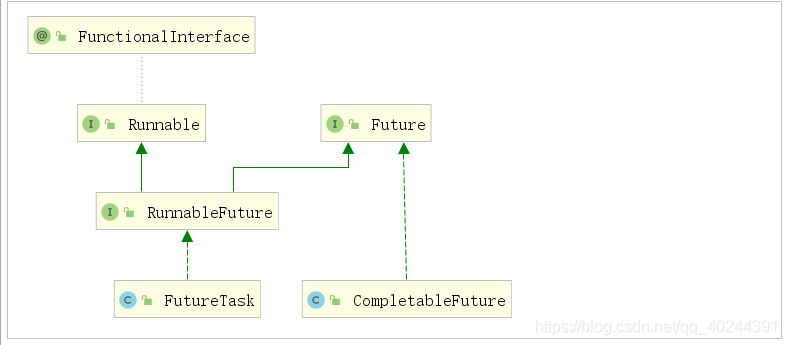提要:在大型的项目某个主业务里,某个请求的调用,需要访问许多个微服务,才可以完成,但由于是远程调用,多微服务调用之间的延迟太高,用户的体验度太差,所以使用异步编排技术,由起初的一个线程执行,到多个线程异步执行,缩短请求的时间。
CompletableFuture介绍
Future是Java 5添加的类,用来描述一个异步计算的结果。你可以使用isDone方法检查计算是否完成,或者使用get阻塞住调用线程,直到计算完成返回结果,你也可以使用cancel方法停止任务的执行。
虽然Future以及相关使用方法提供了异步执行任务的能力,但是对于结果的获取却是很不方便,只能通过阻塞或者轮询的方式得到任务的结果。阻塞的方式显然和我们的异步编程的初衷相违背,轮询的方式又会耗费无谓的CPU资源,而且也不能及时地得到计算结果,为什么不能用观察者设计模式当计算结果完成及时通知监听者呢?
很多语言,比如Node.js,采用回调的方式实现异步编程。Java的一些框架,比如Netty,自己扩展了Java的 Future接口,提供了addListener等多个扩展方法;Google guava也提供了通用的扩展Future;Scala也提供了简单易用且功能强大的Future/Promise异步编程模式。
作为正统的Java类库,是不是应该做点什么,加强一下自身库的功能呢?
在Java 8中, 新增加了一个包含50个方法左右的类: CompletableFuture,提供了非常强大的Future的扩展功能,可以帮助我们简化异步编程的复杂性,提供了函数式编程的能力,可以通过回调的方式处理计算结果,并且提供了转换和组合CompletableFuture的方法。
CompletableFuture类实现了Future接口,所以你还是可以像以前一样通过get方法阻塞或者轮询的方式获得结果,但是这种方式不推荐使用。
CompletableFuture和FutureTask同属于Future接口的实现类,都可以获取线程的执行结果。

创建异步对象
CompletableFuture 提供了四个静态方法来创建一个异步操作。
static CompletableFuture<Void> runAsync(Runnable runnable)
public static CompletableFuture<Void> runAsync(Runnable runnable, Executor executor)
public static <U> CompletableFuture<U> supplyAsync(Supplier<U> supplier)
public static <U> CompletableFuture<U> supplyAsync(Supplier<U> supplier, Executor executor)
没有指定Executor的方法会使用ForkJoinPool.commonPool() 作为它的线程池执行异步代码。如果指定线程池,则使用指定的线程池运行。以下所有的方法都类同。
- runAsync方法不支持返回值。
- supplyAsync可以支持返回值。
计算完成时回调方法
当CompletableFuture的计算结果完成,或者抛出异常的时候,可以执行特定的Action。主要是下面的方法:
public CompletableFuture<T> whenComplete(BiConsumer<? super T,? super Throwable> action);
public CompletableFuture<T> whenCompleteAsync(BiConsumer<? super T,? super Throwable> action);
public CompletableFuture<T> whenCompleteAsync(BiConsumer<? super T,? super Throwable> action, Executor executor);
public CompletableFuture<T> exceptionally(Function<Throwable,? extends T> fn);
whenComplete可以处理正常和异常的计算结果,exceptionally处理异常情况。BiConsumer<? super T,? super Throwable>可以定义处理业务
whenComplete 和 whenCompleteAsync 的区别:
whenComplete:是执行当前任务的线程执行继续执行 whenComplete 的任务。
whenCompleteAsync:是执行把 whenCompleteAsync 这个任务继续提交给线程池来进行执行。
方法不以Async结尾,意味着Action使用相同的线程执行,而Async可能会使用其他线程执行(如果是使用相同的线程池,也可能会被同一个线程选中执行)
代码示例:
public class CompletableFutureDemo {
public static void main(String[] args) throws ExecutionException, InterruptedException {
CompletableFuture future = CompletableFuture.supplyAsync(new Supplier<Object>() {
@Override
public Object get() {
System.out.println(Thread.currentThread().getName() + "\t completableFuture");
int i = 10 / 0;
return 1024;
}
}).whenComplete(new BiConsumer<Object, Throwable>() {
@Override
public void accept(Object o, Throwable throwable) {
System.out.println("-------o=" + o.toString());
System.out.println("-------throwable=" + throwable);
}
}).exceptionally(new Function<Throwable, Object>() {
@Override
public Object apply(Throwable throwable) {
System.out.println("throwable=" + throwable);
return 6666;
}
});
System.out.println(future.get());
}
}
handle 方法
handle 是执行任务完成时对结果的处理。
handleAsync 是在任务完成后再执行,还可以处理异常的任务。
public <U> CompletionStage<U> handle(BiFunction<? super T, Throwable, ? extends U> fn);
public <U> CompletionStage<U> handleAsync(BiFunction<? super T, Throwable, ? extends U> fn);
public <U> CompletionStage<U> handleAsync(BiFunction<? super T, Throwable, ? extends U> fn,Executor executor);
线程串行化方法
thenApply 方法:当一个线程依赖另一个线程时,获取上一个任务返回的结果,并返回当前任务的返回值。
thenAccept方法:消费处理结果。接收任务的处理结果,并消费处理,无返回结果。
thenRun方法:只要上面的任务执行完成,就开始执行thenRun,只是处理完任务后,执行 thenRun的后续操作
带有Async默认是异步执行的。这里所谓的异步指的是不在当前线程内执行。
public <U> CompletableFuture<U> thenApply(Function<? super T,? extends U> fn)
public <U> CompletableFuture<U> thenApplyAsync(Function<? super T,? extends U> fn)
public <U> CompletableFuture<U> thenApplyAsync(Function<? super T,? extends U> fn, Executor executor)
public CompletionStage<Void> thenAccept(Consumer<? super T> action);
public CompletionStage<Void> thenAcceptAsync(Consumer<? super T> action);
public CompletionStage<Void> thenAcceptAsync(Consumer<? super T> action,Executor executor);
public CompletionStage<Void> thenRun(Runnable action);
public CompletionStage<Void> thenRunAsync(Runnable action);
public CompletionStage<Void> thenRunAsync(Runnable action,Executor executor);
Function<? super T,? extends U>
T:上一个任务返回结果的类型
U:当前任务的返回值类型
代码演示:
public static void main(String[] args) throws ExecutionException, InterruptedException {
CompletableFuture<Integer> future = CompletableFuture.supplyAsync(new Supplier<Integer>() {
@Override
public Integer get() {
System.out.println(Thread.currentThread().getName() + "\t completableFuture");
//int i = 10 / 0;
return 1024;
}
}).thenApply(new Function<Integer, Integer>() {
@Override
public Integer apply(Integer o) {
System.out.println("thenApply方法,上次返回结果:" + o);
return o * 2;
}
}).whenComplete(new BiConsumer<Integer, Throwable>() {
@Override
public void accept(Integer o, Throwable throwable) {
System.out.println("-------o=" + o);
System.out.println("-------throwable=" + throwable);
}
}).exceptionally(new Function<Throwable, Integer>() {
@Override
public Integer apply(Throwable throwable) {
System.out.println("throwable=" + throwable);
return 6666;
}
}).handle(new BiFunction<Integer, Throwable, Integer>() {
@Override
public Integer apply(Integer integer, Throwable throwable) {
System.out.println("handle o=" + integer);
System.out.println("handle throwable=" + throwable);
return 8888;
}
});
System.out.println(future.get());
}
两任务组合 - 都要完成
两个任务必须都完成,触发该任务。
thenCombine:组合两个future,获取两个future的返回结果,并返回当前任务的返回值
thenAcceptBoth:组合两个future,获取两个future任务的返回结果,然后处理任务,没有返回值。
runAfterBoth:组合两个future,不需要获取future的结果,只需两个future处理完任务后,处理该任务。
public <U,V> CompletableFuture<V> thenCombine(
CompletionStage<? extends U> other,
BiFunction<? super T,? super U,? extends V> fn);
public <U,V> CompletableFuture<V> thenCombineAsync(
CompletionStage<? extends U> other,
BiFunction<? super T,? super U,? extends V> fn);
public <U,V> CompletableFuture<V> thenCombineAsync(
CompletionStage<? extends U> other,
BiFunction<? super T,? super U,? extends V> fn, Executor executor);
public <U> CompletableFuture<Void> thenAcceptBoth(
CompletionStage<? extends U> other,
BiConsumer<? super T, ? super U> action);
public <U> CompletableFuture<Void> thenAcceptBothAsync(
CompletionStage<? extends U> other,
BiConsumer<? super T, ? super U> action);
public <U> CompletableFuture<Void> thenAcceptBothAsync(
CompletionStage<? extends U> other,
BiConsumer<? super T, ? super U> action, Executor executor);
public CompletableFuture<Void> runAfterBoth(CompletionStage<?> other,
Runnable action);
public CompletableFuture<Void> runAfterBothAsync(CompletionStage<?> other,
Runnable action);
public CompletableFuture<Void> runAfterBothAsync(CompletionStage<?> other,
Runnable action,
Executor executor);
测试案例:
public static void main(String[] args) {
CompletableFuture.supplyAsync(() -> {
return "hello";
}).thenApplyAsync(t -> {
return t + " world!";
}).thenCombineAsync(CompletableFuture.completedFuture(" CompletableFuture"), (t, u) -> {
return t + u;
}).whenComplete((t, u) -> {
System.out.println(t);
});
}
输出:hello world! CompletableFuture
两任务组合 - 一个完成
当两个任务中,任意一个future任务完成的时候,执行任务。
applyToEither:两个任务有一个执行完成,获取它的返回值,处理任务并有新的返回值。
acceptEither:两个任务有一个执行完成,获取它的返回值,处理任务,没有新的返回值。
runAfterEither:两个任务有一个执行完成,不需要获取future的结果,处理任务,也没有返回值。
public <U> CompletableFuture<U> applyToEither(
CompletionStage<? extends T> other, Function<? super T, U> fn);
public <U> CompletableFuture<U> applyToEitherAsync(
CompletionStage<? extends T> other, Function<? super T, U> fn);
public <U> CompletableFuture<U> applyToEitherAsync(
CompletionStage<? extends T> other, Function<? super T, U> fn,
Executor executor);
public CompletableFuture<Void> acceptEither(
CompletionStage<? extends T> other, Consumer<? super T> action);
public CompletableFuture<Void> acceptEitherAsync(
CompletionStage<? extends T> other, Consumer<? super T> action);
public CompletableFuture<Void> acceptEitherAsync(
CompletionStage<? extends T> other, Consumer<? super T> action,
Executor executor);
public CompletableFuture<Void> runAfterEither(CompletionStage<?> other,
Runnable action);
public CompletableFuture<Void> runAfterEitherAsync(CompletionStage<?> other,
Runnable action);
public CompletableFuture<Void> runAfterEitherAsync(CompletionStage<?> other,
Runnable action,
Executor executor);
多任务组合
public static CompletableFuture<Void> allOf(CompletableFuture<?>... cfs);
public static CompletableFuture<Object> anyOf(CompletableFuture<?>... cfs);
allOf:等待所有任务完成
anyOf:只要有一个任务完成
public static void main(String[] args) {
List<CompletableFuture> futures = Arrays.asList(CompletableFuture.completedFuture("hello"),
CompletableFuture.completedFuture(" world!"),
CompletableFuture.completedFuture(" hello"),
CompletableFuture.completedFuture("java!"));
final CompletableFuture<Void> allCompleted = CompletableFuture.allOf(futures.toArray(new CompletableFuture[]{}));
allCompleted.thenRun(() -> {
futures.stream().forEach(future -> {
try {
System.out.println("get future at:"+System.currentTimeMillis()+", result:"+future.get());
} catch (InterruptedException | ExecutionException e) {
e.printStackTrace();
}
});
});
}
测试结果:
get future at:1568892339473, result:hello
get future at:1568892339473, result: world!
get future at:1568892339473, result: hello
get future at:1568892339473, result:java!
几乎同时完成任务!
样例:
public ItemVO queryItemVO(Long skuId) {
ItemVO itemVO = new ItemVO();
//根据sku的id查询sku
CompletableFuture<SkuInfoEntity> completableFuture = CompletableFuture.supplyAsync(() -> {
itemVO.setSkuId(skuId);
Resp<SkuInfoEntity> skuInfoEntityResp = pmsClient.querySkuById(skuId);
SkuInfoEntity skuInfoEntity = skuInfoEntityResp.getData();
if (skuInfoEntity == null) {
return null;
}
itemVO.setWeight(skuInfoEntity.getWeight());
itemVO.setSkuTitle(skuInfoEntity.getSkuTitle());
itemVO.setSkuSubtitle(skuInfoEntity.getSkuSubtitle());
itemVO.setPrice(skuInfoEntity.getPrice());
return skuInfoEntity;
},threadPoolExecutor);
//根据sku中的品牌的id查询分类
//thenAcceptAsync:有参数,无返回
//thanApplyAsync: 有参数,有返回
CompletableFuture<Void> cateCompletablbe = completableFuture.thenAcceptAsync(skuInfoEntity -> {
Resp<CategoryEntity> categoryEntityResp = pmsClient.queryCategoryById1(skuInfoEntity.getCatalogId());
CategoryEntity categoryEntity = categoryEntityResp.getData();
if (categoryEntity != null) {
itemVO.setCategoryId(categoryEntity.getCatId());
itemVO.setCategoryName(categoryEntity.getName());
}
},threadPoolExecutor);
//根据sku中的brandID查询品牌
CompletableFuture<Void> brandCompletablbe = completableFuture.thenAcceptAsync(skuInfoEntity -> {
Resp<BrandEntity> brandEntityResp = pmsClient.queryBrandById(skuInfoEntity.getBrandId());
BrandEntity brandEntity = brandEntityResp.getData();
if(brandEntity!=null){
itemVO.setBrandId(brandEntity.getBrandId());
itemVO.setBrandName(brandEntity.getName());
}
},threadPoolExecutor);
//根据sku中的spu查询spu
CompletableFuture<Void> spuCompletable = completableFuture.thenAcceptAsync(skuInfoEntity -> {
Resp<SpuInfoEntity> spuInfoEntityResp = pmsClient.querySpuById(skuInfoEntity.getSpuId());
SpuInfoEntity spuInfoEntity = spuInfoEntityResp.getData();
if (skuInfoEntity != null) {
itemVO.setSpuId(spuInfoEntity.getId());
itemVO.setSpuName(spuInfoEntity.getSpuName());
}
},threadPoolExecutor);
//根据sku中的信息查询图片
CompletableFuture<Void> imagesCompletableFuture = CompletableFuture.runAsync(() -> {
Resp<List<SkuImagesEntity>> queryImagesBySkuId = pmsClient.queryImagesBySkuId(skuId);
List<SkuImagesEntity> imagesEntities = queryImagesBySkuId.getData();
if (!CollectionUtils.isEmpty(imagesEntities)) {
itemVO.setImeges(imagesEntities);
}
},threadPoolExecutor);
//根据skuid查询库存
CompletableFuture<Void> skuCompletableFuture = CompletableFuture.runAsync(() -> {
Resp<List<WareSkuEntity>> listResp = wmsClient.querySkuBySpuId(skuId);
List<WareSkuEntity> wareSkuEntities = listResp.getData();
if (!CollectionUtils.isEmpty(wareSkuEntities)) {
itemVO.setStore(wareSkuEntities.stream().anyMatch(wareSkuEntity -> wareSkuEntity.getStock() > 0));
}
},threadPoolExecutor);
//根据skuid查询营销信息3个
CompletableFuture<Void> saleCompletableFuture = CompletableFuture.runAsync(() -> {
Resp<List<ItemSaleVO>> listResp1 = this.smsClient.querySaleVoBySkuId(skuId);
List<ItemSaleVO> itemSaleVOList = listResp1.getData();
itemVO.setSales(itemSaleVOList);
},threadPoolExecutor);
//根据sku中的spuID查询描述信息
CompletableFuture<Void> descCompletableFuture = completableFuture.thenAcceptAsync(skuInfoEntity -> {
Resp<SpuInfoDescEntity> spuInfoDescEntityResp = pmsClient.querySpuDescBySpuId(skuInfoEntity.getSpuId());
SpuInfoDescEntity spuInfoDescEntity = spuInfoDescEntityResp.getData();
if (spuInfoDescEntity != null && StringUtils.isNotBlank(spuInfoDescEntity.getDecript())) {
itemVO.setDesc(Arrays.asList(StringUtils.split(spuInfoDescEntity.getDecript(), ",")));
}
},threadPoolExecutor);
CompletableFuture<Void> groupCompletableFuture = completableFuture.thenAcceptAsync(skuInfoEntity -> {
Resp<List<ItemGroupVO>> listResp2 = this.pmsClient.queryItemGroupVOsByCidAndSpuId(skuInfoEntity.getCatalogId(), skuInfoEntity.getSpuId());
List<ItemGroupVO> itemGroupVOS = listResp2.getData();
itemVO.setGroupVOS(itemGroupVOS);
},threadPoolExecutor);
//根据sku中的spuId查询skus
//根据skuIds查询销售属性
CompletableFuture<Void> attrValueCompletableFuture = completableFuture.thenAcceptAsync(skuInfoEntity -> {
Resp<List<SkuSaleAttrValueEntity>> listResp3 = pmsClient.querySaleAttrValueBySpuId(skuInfoEntity.getSpuId());
List<SkuSaleAttrValueEntity> skuSaleAttrValueEntities = listResp3.getData();
itemVO.setSaleAttrs(skuSaleAttrValueEntities);
},threadPoolExecutor);
CompletableFuture.allOf(completableFuture,cateCompletablbe,brandCompletablbe,spuCompletable,imagesCompletableFuture
,skuCompletableFuture,saleCompletableFuture,descCompletableFuture,
groupCompletableFuture,attrValueCompletableFuture).join();
return itemVO;
}
